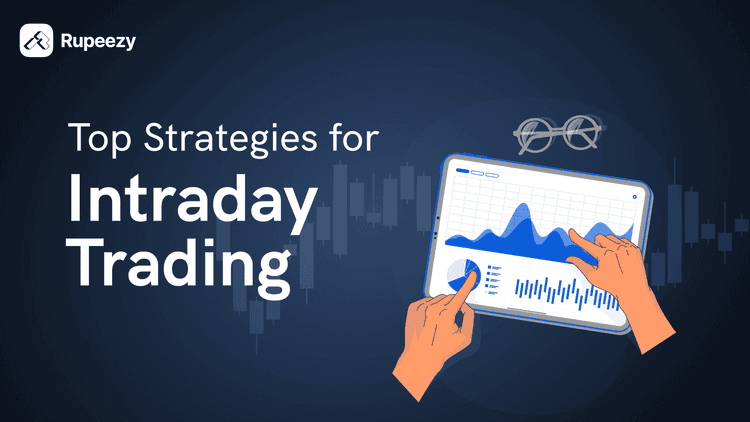What is Intraday Margin - Meaning, Examples and More


00:00 / 00:00
Intraday margin is popular among new and seasoned traders because it offers a chance to make quick returns by closing trades within the same day. In this approach, your capital isn't tied up for long periods, unlike traditional delivery trades.
One of the key benefits of intraday margin is that you need less upfront capital. For example, with Rs. 100, you can buy shares worth Rs. 100 on a delivery basis. However, with intraday leverage, the same Rs. 100 allows you to trade shares worth Rs. 400. This leverage can significantly boost your potential profits.
In the following sections, we'll explore what is intraday margin, how it works, its pros and cons. So let's get started.
What is Intraday Margin
Intraday margin is the leverage brokers provide, enabling traders to buy or sell stocks worth more than their available capital within a single trading day. This leverage can significantly amplify both potential profits and losses, as trades are executed and closed within the same market session.
How Does Intraday Margin Work
To understand how margin works in intraday trading, first, let us understand the concept of Intraday Trading. In this trading style, you can buy or sell a share within a single market session day, i.e. without taking delivery of the stock in your demat account.
For example, if you buy a stock at 11 AM for Rs. 200 and its value rises to Rs. 220 during the day, you can sell it for a Rs. 20 per share profit. If you had purchased 1,000 shares for Rs. 200,000, your overall profit would be Rs. 20,000, which is a 10% gain within a day. Conversely, if the share price falls, you could incur losses just as quickly.
Now, let's explore how intraday margin trading works: Imagine you spot an opportunity where a share price is Rs. 200. You have Rs. 50,000 in capital but want to buy at least 1,000 shares, requiring more than Rs. 200,000. By placing Rs. 50,000 in your trading account and applying for a 4x margin facility with your broker, you can trade with Rs. 200,000 of borrowed funds. This gives you Rs. 250,000 in total to trade, allowing you to buy 1,250 shares.
If the share price rises to Rs. 210, your profit calculation is:
Profit per share: Rs. 10
Total profit: 1,250 shares x Rs. 10 = Rs. 12,500
Profit as a percentage of total capital: 5%
Profit as a percentage of initial capital: 25% (less interest paid)
With leverage, you can achieve much larger profits with a small initial capital. However, the downside is also magnified due to leverage.
Most brokers offer this margin, or credit, to their customers based on eligibility. This practice is known as margin in intraday trading, also referred to as Margin Trading Facility (MTF) or PayLater. Brokers charge interest on the funds provided, calculated based on the amount and duration of the funding used.
Who is Eligible for Intraday Margin
Any investor can open demat account and trading account with intraday trading enabled. This is subject to the necessary documents being submitted during the account opening process.
Intraday margin trading is automatically enabled for all traders who choose equity trading. However, if you want to trade in the futures and options segment, you’ll need to provide income proof.
As an intraday trader, it’s a good idea to compare different brokers. Look for a registered broker that offers competitive interest rates, fast processing, and excellent trading features and user experience. This will help you get the most out of your trading activities.
SEBI New Rules for Intraday Margin
To regulate the market and risks involved, SEBI mandated that from September 2021 a stockbroker can provide a maximum of 5x margin to traders. Earlier the limit used to be even 40-50 times before SEBI came up with new margin guidelines.
Apart from this, a trader needs to maintain 50% of the investment value as the initial margin. As for the maintenance margin, the range has to be 40% of the current market value.
Also, as per the new SEBI guidelines for intraday trading margin, a trader needs to fulfill all the margin requirements before the start of the market session.
What is Day Trading Margin Call
Day trading with margin can give you extra buying power, but it also comes with risks. It's important for traders to maintain both the margin and maintenance values in their accounts to avoid a margin call.
A margin call occurs when your account balance falls below the minimum required margin. In such cases, the broker may close your positions to recover the shortfall if you don't take action.
Let’s illustrate this with an example:
Imagine you have a capital of Rs. 20,000 and apply for margin trading. With a 5x margin, your total purchasing power is Rs. 100,000. You buy shares of Company Y worth Rs. 100,000. Later, you decide to buy shares of Company Z for Rs. 50,000. At this point, you might find that you’re falling short of the required margin in your account.
If you don't sell off your position in Company Y, your broker will issue a margin call, prompting you to either add more funds to your account or close your position to avoid further losses.
Advantages of Intraday Margin
Intraday trading margin allows you to access more capital quickly to take advantage of market opportunities and earn higher returns even with a small upfront investment.
Intraday trading margin usually carries a lower interest rate compared to retail loan products.
Intraday margin is processed instantly, with no hassles or time-consuming paperwork. You can access up to 5x instant margin for equity intraday trading with Rupeezy. Use our Margin Calculator to check margin availability on your chosen stocks.
You can pledge shares in your demat holding and avail margin funding against the applicable value.
Many brokers offer special rates for margin funding. Rupeezy offers one of the lowest MTF interest rate of 3.99% on equity delivery with an annual subscription.
Disadvantages of Intraday Margin
Just as profit potential is higher with intraday margin, the propensity to suffer losses is also magnified.
You need to maintain a minimum balance in your account as per SEBI norms, or the broker can liquidate your holdings and it results in losses.
Conclusion
In summary, utilizing intraday margin can be a game-changer for traders looking to boost their liquidity and profit potential. It allows you to leverage your capital and seize quick trading opportunities. However, it’s essential to tread carefully, as the potential for significant losses is just as real as the potential for gains.
Always choose your stocks wisely and align your trades with your risk appetite and financial goals. Remember, with great power comes great responsibility so make sure you’re prepared to handle the ups and downs that come with intraday trading.
For those interested in maximizing their trading experience, Rupeezy offers fantastic deals for both intraday and delivery trading. Be sure to check them out!
The content on this blog is for educational purposes only and should not be considered investment advice. While we strive for accuracy, some information may contain errors or delays in updates.
Mentions of stocks or investment products are solely for informational purposes and do not constitute recommendations. Investors should conduct their own research before making any decisions.
Investing in financial markets are subject to market risks, and past performance does not guarantee future results. It is advisable to consult a qualified financial professional, review official documents, and verify information independently before making investment decisions.
Open Rupeezy account now. It is free and 100% secure.
Start Stock InvestmentAll Category









